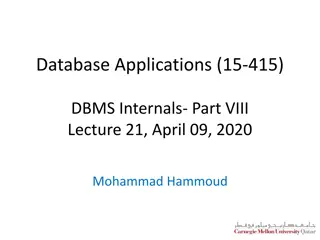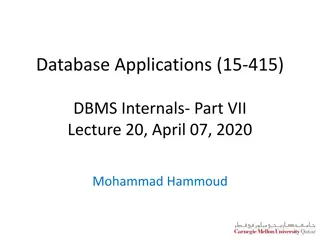
GROUP BY and INNER JOINs in Data Management
Explore the concepts of GROUP BY and INNER JOINs in data management, with insights on integer division, aggregation functions, subqueries, and practical examples illustrating how GROUP BY works to combine and aggregate data effectively.
Download Presentation

Please find below an Image/Link to download the presentation.
The content on the website is provided AS IS for your information and personal use only. It may not be sold, licensed, or shared on other websites without obtaining consent from the author. If you encounter any issues during the download, it is possible that the publisher has removed the file from their server.
You are allowed to download the files provided on this website for personal or commercial use, subject to the condition that they are used lawfully. All files are the property of their respective owners.
The content on the website is provided AS IS for your information and personal use only. It may not be sold, licensed, or shared on other websites without obtaining consent from the author.
E N D
Presentation Transcript
EECS-317 Data Management and Information Processing Lecture 4 GROUP BY and INNER JOINs Steve Tarzia Spring 2019
Announcements First HW assignment is due Monday night.
Last lecture: Integer division, aggregation, subqueries When dividing two integers, the result is always rounded down. You may have to multiply by 1.0 in your SQL formulas to convert to floats. COUNT, SUM, MIN, MAX, AVG are aggregation functions Operate on all rows unless GROUP BY is used. Subqueries can be used to replace a single value, list of values, or an entire table in a parent query. Answered ten sample questions in class.
GROUP BY explained GROUP BY combines multiple rows into one row in the result. Rows with the same value for the grouping criterion are grouped. An aggregation function should be applied. SELECT CategoryID, COUNT(*) AS category_count, MAX(RetailPrice) AS most_expensive_price FROM Products GROUP BY CategoryID;
The GROUP BY expression GROUP BY x means: Each row in the output will represent many aggregated rows having the same value for x. Thus, the number of rows in the result is the number of distinct values taken by x (after the WHERE filtering). Usually it s just the name of a column, but it can be an arbitrary expression.
SELECT category, AVG(price) FROM product GROUP BY category Table product id name price 1 Quart Skim Milk 2.49 2 Rye Bread 1.99 3 1lb Butter 5.99 4 32oz Yogurt 4.99 5 Navel Orange (each) 0.89 6 Pineapple (each) 1.99 7 English Muffins 3.99 8 Spinach (bunch) 1.49 9 Carrots (lb bag) 0.99 10 Dozen Eggs 2.49 Output category 1 2 3 category 3 1 3 3 2 2 1 2 2 3 AVG(price) 2.99 1.34 3.99 This is a typical GROUP BY example.
SELECT price, COUNT(*) FROM product GROUP BY price ORDER BY price Table product id name price category 1 Quart Skim Milk 2.49 3 2 Rye Bread 1.99 1 3 1lb Butter 5.99 3 4 32oz Yogurt 4.99 3 5 Navel Orange (each) 0.89 2 6 Pineapple (each) 1.99 2 7 English Muffins 3.99 1 8 Spinach (bunch) 1.49 2 9 Carrots (lb bag) 0.99 2 10 Dozen Eggs 2.49 3 Output price COUNT(*) 0.89 0.99 1.49 1.99 2.49 3.99 4.99 5.99 1 1 1 2 2 1 1 1 This is a typical GROUP BY example.
SELECT category, price FROM product GROUP BY category Table product id name price 1 Quart Skim Milk 2.49 2 Rye Bread 1.99 3 1lb Butter 5.99 4 32oz Yogurt 4.99 5 Navel Orange (each) 0.89 6 Pineapple (each) 1.99 7 English Muffins 3.99 8 Spinach (bunch) 1.49 9 Carrots (lb bag) 0.99 10 Dozen Eggs 2.49 Output category category 3 1 3 3 2 2 1 2 2 3 price 1 2 3 1.99 0.89 2.49 This GROUP BY is weird. It s missing an aggregation function (like SUM, MIN, etc.). It prints a random price for each category.
SELECT id, name FROM product GROUP BY id Table product id name 1 Quart Skim Milk 2 Rye Bread 3 1lb Butter 4 32oz Yogurt 5 Navel Orange (each) 6 Pineapple (each) 7 English Muffins 8 Spinach (bunch) 9 Carrots (lb bag) 10 Dozen Eggs Output id 1 2 3 4 5 6 7 8 9 10 price 2.49 1.99 5.99 4.99 0.89 1.99 3.99 1.49 0.99 2.49 category 3 1 3 3 2 2 1 2 2 3 name Quart Skim Milk Rye Bread 1lb Butter 32oz Yogurt Navel Orange (each) Pineapple (each) English Muffins Spinach (bunch) Carrots (lb bag) Dozen Eggs This GROUP BY is useless because id is always different.
SELECT AVG(price) FROM product GROUP BY hello Table product id name price 1 Quart Skim Milk 2.49 2 Rye Bread 1.99 3 1lb Butter 5.99 4 32oz Yogurt 4.99 5 Navel Orange (each) 0.89 6 Pineapple (each) 1.99 7 English Muffins 3.99 8 Spinach (bunch) 1.49 9 Carrots (lb bag) 0.99 10 Dozen Eggs 2.49 Output AVG(price) 2.73 category 3 1 3 3 2 2 1 2 2 3 This GROUP BY is weird. hello is the same for every row, so it always aggregates all rows to one output row. AVG would have given the same result without any GROUP BY.
SELECT category=2, AVG(price) FROM product GROUP BY category=2 Table product id name price 1 Quart Skim Milk 2.49 2 Rye Bread 1.99 3 1lb Butter 5.99 4 32oz Yogurt 4.99 5 Navel Orange (each) 0.89 6 Pineapple (each) 1.99 7 English Muffins 3.99 8 Spinach (bunch) 1.49 9 Carrots (lb bag) 0.99 10 Dozen Eggs 2.49 Output category=2 0 (false) 1 (true) category 3 1 3 3 2 2 1 2 2 3 AVG(price) 3.6566667 1.34 This is an advanced GROUP BY example. It divides the rows into two groups, those with category=2 in one group and everything else in the other group. Prints the average price of fruits & vegetables vs the average price of other foods.
What if you need to combine data from multiple tables? 1. FROM chooses the table of interest 2. WHERE throws out irrelevant rows 3. GROUP BY identifies rows to combine 4. SELECT tells what values to return (allowing math and aggregation) 5. HAVING throws out irrelevant rows (after aggregation) 6. ORDER BY sorts 7. LIMIT throws out rows based on their position in the results A subquery can draw data from another table, but JOINs are a more powerful way to use multiple tables.
JOINs create virtual tables from several tables Normalizing this staff directory left us with three tables This split eliminated redundant information, but now we have to look in three different tables to answer some questions. staff department building id name room departmentId id name buildingId id name faxNumber 11 Bob 100 1 1 Industrial Eng. 1 1 Tech 1-1000 20 Betsy 100 2 2 Computer Sci. 2 2 Ford 1-5003 21 Fran 101 1 4 Chemistry 1 4 Mudd 1-2005 22 Frank 102 4 5 Physics 4 5 Cook 1-3004 35 Sarah 200 5 7 Materials Sci. 5 6 Garage 1-6001 40 Sam 10 7 54 Pat 102 2
What if we want to print the staff directory? staff id 11 20 21 22 35 40 54 name Bob Betsy Fran Frank Sarah Sam Pat department Industrial Eng. Computer Sci. Industrial Eng. Chemistry Physics Materials Sci. Computer Sci. building Tech Ford Tech Tech Mudd Cook Ford room 100 100 101 102 200 10 102 faxNumber 1-1000 1-5003 1-1000 1-1000 1-2005 1-3004 1-5003 We can generate a virtual table like this with INNER JOIN
staff department id name room departmentId id name buildingId 11 Bob 100 1 1 Industrial Eng. 1 20 Betsy 100 2 2 Computer Sci. 2 21 Fran 101 1 4 Chemistry 1 22 Frank 102 4 5 Physics 4 35 Sarah 200 5 7 Materials Sci. 5 40 Sam 10 7 ON tells how rows are matched 54 Pat 102 2 SELECT * FROM staff JOIN department ON staff.departmentId=department.id staff.id 11 20 21 22 35 40 54 staff.name Bob Betsy Fran Frank Sarah Sam Pat staff.room 100 100 101 102 200 10 102 staff.departmentId 1 2 1 4 5 7 2 department.id 1 2 1 4 5 7 2 department.name Industrial Eng. Computer Sci. Industrial Eng. Chemistry Physics Materials Sci. Computer Sci. department.buildingId 1 2 1 1 4 5 2
How JOIN builds a composite table SELECT * FROM staff JOIN department ON staff.departmentId=department.id Start with the first table (staff) Join with rows from the 2nd table (department) that match according to the ON columns staff.id 11 20 21 22 35 40 54 staff.name Bob Betsy Fran Frank Sarah Sam Pat staff.room 100 100 101 102 200 10 102 staff.departmentId 1 2 1 4 5 7 2 department.id 1 2 1 4 5 7 2 department.name Industrial Eng. Computer Sci. Industrial Eng. Chemistry Physics Materials Sci. Computer Sci. department.buildingId 1 2 1 1 4 5 2
Just print the columns we need SELECT staff.id, staff.name, staff.room, department.name, department.buildingId FROM staff JOIN department ON staff.departmentId=department.id staff.id 11 20 21 22 35 40 54 staff.name Bob Betsy Fran Frank Sarah Sam Pat staff.room 100 100 101 102 200 10 102 department.name Industrial Eng. Computer Sci. Industrial Eng. Chemistry Physics Materials Sci. Computer Sci. department.buildingId 1 2 1 1 4 5 2
Reorder and rename the columns SELECT staff.id AS staffID, staff.name AS name, department.name AS department, department.buildingId AS buildingId, staff.room AS room FROM staff JOIN department ON staff.departmentId=department.id staffId 11 20 21 22 35 40 54 name Bob Betsy Fran Frank Sarah Sam Pat department Industrial Eng. Computer Sci. Industrial Eng. Chemistry Physics Materials Sci. Computer Sci. buildingId 1 2 1 1 4 5 2 room 100 100 101 102 200 10 102
JOIN to the third table SELECT staff.id AS staffId, staff,name, department.name AS department, building.name AS building, staff.room AS room, building.faxNumber AS faxNumber FROM staff JOIN department ON staff.departmentId=department.id JOIN building ON department.buildingId=building.id staffId 11 20 21 22 35 40 54 name Bob Betsy Fran Frank Sarah Sam Pat department Industrial Eng. Computer Sci. Industrial Eng. Chemistry Physics Materials Sci. Computer Sci. building Tech Ford Tech Tech Mudd Cook Ford room 100 100 101 102 200 10 102 faxNumber 1-1000 1-5003 1-1000 1-1000 1-2005 1-3004 1-5003
Who teaches the largest class & what is the average grade? Instructor names are in Staff table Instructor class assignments are in Faculty_Classes table. Class enrollments are in Student_Schedules table Can use two subqueries to answer the first part of the question: Get the largest class: SELECT ClassID FROM Student_Schedules GROUP BY ClassID ORDER BY COUNT(*) DESC LIMIT 1; Get the instructor ID of that class: SELECT StaffID FROM Faculty_Classes WHERE ClassID= Get the instructor name: SELECT StfFirstName, StfLastName FROM Staff WHERE StaffID= SELECT StfFirstName, StfLastName FROM Staff WHERE StaffID= (SELECT StaffID FROM Faculty_Classes WHERE ClassID= (SELECT ClassID FROM Student_Schedules GROUP BY ClassID ORDER BY COUNT(*) DESC LIMIT 1));
Who teaches the largest class & what is the average grade? Alternative approach: Use JOINs to create a composite table listing instructors, classes, and their average grades: SELECT Student_Schedules.ClassID, StfLastname, AVG(Grade) FROM Student_Schedules JOIN Faculty_Classes ON Student_Schedules.ClassID=Faculty_Classes.ClassID JOIN Staff ON Faculty_Classes.StaffID = Staff.StaffID GROUP BY Student_Schedules.ClassID ORDER BY COUNT(*) DESC LIMIT 1;
Using INNER JOIN, what if rows dont match one-to-one? In output, multiple matches leads to multiple rows. no matches leads to no rows staff department id name room departmentId id name buildingId 11 Bob 100 1 1 Industrial Eng. 1 20 Betsy 100 2 2 Computer Sci. 2 21 Fran 101 1 4 Chemistry 1 1 Physics 4 SELECT * FROM staff JOIN department ON staff.departmentId=department.id 1 Materials Sci. 5 staff.id 11 11 11 20 21 21 21 staff.name Bob Bob Bob Betsy Fran Fran Fran staff.room 100 100 100 100 101 101 101 staff.departmentId 1 1 1 2 1 1 1 department.id 1 1 1 2 1 1 1 department.name Industrial Eng. Physics Materials Sci. Computer Sci. Industrial Eng. Physics Materials Sci. department.buildingId 1 4 5 2 1 4 5
(Recipes.sqlite) Print the recipe for Irish Stew (RecipeID = 1)
(Recipes.sqlite) Print the recipe for Irish Stew (RecipeID = 1) SELECT RecipeSeqNo, Amount, Measurements.MeasurementDescription, IngredientName FROM Recipe_Ingredients JOIN Ingredients ON Recipe_Ingredients.IngredientId = Ingredients.IngredientID JOIN Measurements ON Recipe_Ingredients.MeasureAmountID = Measurements.MeasureAmountID WHERE RecipeId=1 ORDER BY RecipeSeqNo;
What is the name of the recipe with the most ingredients? (Can be done with either a subquery or a JOIN)
What is the name of the recipe with the most ingredients? SELECT RecipeTitle, COUNT(*) AS numIngredients FROM Recipe_Ingredients JOIN Recipes ON Recipes.RecipeID = Recipe_Ingredients.RecipeID ORDER BY numIngredients DESC LIMIT 1 GROUP BY Recipes.RecipeID
(BowlingLeague.sqlite) Print a schedule of all the team matchups over the whole season (Date, Location, TeamName, TeamName)
Print a schedule of all the team matchups over the whole season (Date, Location, TeamName, TeamName) SELECT TourneyDate, TourneyLocation, OddTeam.TeamName, EvenTeam.TeamName FROM Tourney_Matches JOIN Tournaments ON Tourney_Matches.TourneyID = Tournaments.TourneyID JOIN Teams AS OddTeam ON OddLaneTeamID=OddTeam.TeamID JOIN Teams AS EvenTeam ON EvenLaneTeamID = EvenTeam.TeamID
Print game results for Tournament #1, including bowler names, team names, & raw score
Print game results for Tournament #1, including bowler names, team names, & raw score SELECT Bowler_Scores.MatchID, GameNumber, TeamName, BowlerFirstName || " " || BowlerLastName AS Bowler, RawScore FROM Bowler_Scores JOIN Tourney_Matches ON Bowler_Scores.MatchID = Tourney_Matches.MatchID JOIN Bowlers ON Bowlers.BowlerID = Bowler_Scores.BowlerID JOIN Teams ON Bowlers.TeamID = Teams.TeamID WHERE TourneyId=1

















